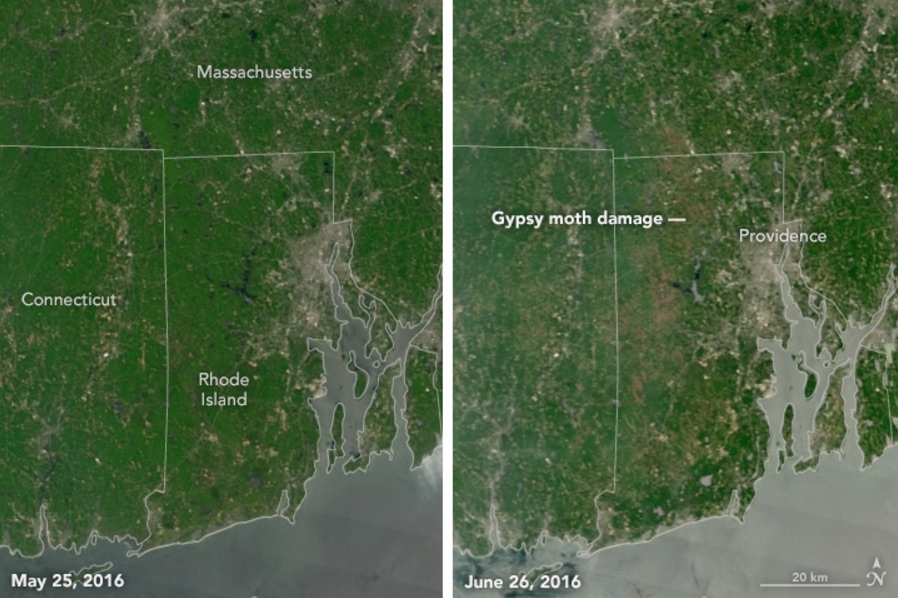Space Shot Shows Gypsy Caterpillars' Rampage Through Forests

The gypsy moth caterpillar may be small, but the amount of destruction it's causing to the trees in New England and the Mid-Atlantic region is so vast that it's visible from space, NASA satellite photos show.
Within the span of one month, European gypsy moth caterpillars (Lymantria dispar) chewed through so much tree foliage in New England and the Mid-Atlantic region that much of what appeared green in satellite images in May had turned brown by June, NASA images showed.
Gypsy caterpillars aren't the only tree-killing critters. Insects and diseases combined to ravage about 45 percent more forest area each year than did wildfires, according to a 2001 study in the journal BioScience. [Gallery: Out-of-This-World Images of Insects]
But the invasive gypsy moth caterpillar is among the worst of these offenders. NASA's Aqua and Terra satellites captured snapshots of the destruction, with the help of natural-color images taken by Terra's Moderate Resolution Imaging Spectroradiometer (MODIS) sensor on May 25 and June 26, NASA's Earth Observatory reported.
From the moment they're born in early summer, the brown, fuzzy caterpillars voraciously munch on leaves, NASA said in a statement. They avoid coniferous trees, such as firs and pines, and target deciduous trees (such as oaks, that lose their leaves in the fall), which make up most of New England's hardwood forests.
Another image of the destruction, this one an aerial photo, was taken near the Barden and Scituate reservoirs in Rhode Island on June 30, clearly showing the caterpillars' preference for deciduous tree leaves: The surviving green trees are all conifers, while the brown swaths are defoliated deciduous trees, NASA said.
Though they're not natives to the area, gypsy moths have lived in the United States since the 1860s. In recent years, several factors have caused their numbers to swell, including the decline of white-footed mice, a predator that eats gypsy moth caterpillars. These mice also eat acorns from oak trees, and a poor acorn production has caused the mouse's numbers to shrink, NASA said.
Get the world’s most fascinating discoveries delivered straight to your inbox.
Moreover, dry weather weakens some pathogens that usually keep caterpillar numbers in check.
"This 2016 outbreak is likely due to two successive dry springs — conditions not conducive to the growth and spread of two naturally occurring [pathogens]," Paul Ricard, the forest health program coordinator for the Rhode Island Department of Environmental Management, said in the NASA statement. "The Entomophaga maimaiga fungus and Nuclepolyhedrosis virus have historically kept the gypsy moth population in check."
As a case in point, a moderate to severe drought is affecting much of the American Northeast right now, the U.S. Drought Monitor reported.
Conversely, cold winters tend to dampen the moth's numbers. Subfreezing temperatures, including those that accompanied the polar vortex, are lethal to the moth's larvae, Live Science reported in 2014. There are also other viruses that target the caterpillar, including baculovirus, which turns the critters into "zombies" that compulsively climb to the tops of trees and die as they're waiting to molt, Kelli Hoover, an entomologist at Pennsylvania State University, told Live Science in 2011.
For now, the gypsy moth outbreak may appear mostly cosmetic, but they can have serious consequences as time goes on. Deciduous trees can often survive one to two years of defoliation, but three or more consecutive years can kill the trees, the researchers said.
"Though weak or sick trees could succumb, we are not worried about significant tree mortality yet," Ricard said.
In the meantime, cuckoos, blue jays and orioles may benefit from the gypsy moth caterpillar outbreak, as these birds usually chow down on the caterpillars whenever the opportunity arises, NASA said.
Original article on Live Science.

Laura is the managing editor at Live Science. She also runs the archaeology section and the Life's Little Mysteries series. Her work has appeared in The New York Times, Scholastic, Popular Science and Spectrum, a site on autism research. She has won multiple awards from the Society of Professional Journalists and the Washington Newspaper Publishers Association for her reporting at a weekly newspaper near Seattle. Laura holds a bachelor's degree in English literature and psychology from Washington University in St. Louis and a master's degree in science writing from NYU.



